M8 M73 M74 Motorway Improvements
Overview
The M8 M73 M74 Motorway Improvements Project represents the delivery of an ambitious project to upgrade the core of Scotland’s motorway network, to boost Scotland’s economy by improving connections between the commercial centres of Glasgow and Edinburgh and beyond.
This major £500m Scottish Government investment aims to bring the following benefits:
- improved journey times and journey time reliability through the Central Scotland motorway network
- promotion of sustainable economic growth by improving access to facilities and employment areas
- reduced emissions to improve air quality providing health improvement
- better connectivity between Glasgow and Edinburgh and to the south
- reduced congestion
- improved road safety through the reduction of traffic on local roads, reducing lane changing and helping prevent weaving between lanes
The new and improved M8, M73 and M74 motorways progressively opened during spring 2017 and were fully open to traffic on Thursday 1st June 2017 and included:
- a new motorway between Baillieston and Newhouse, completing the M8 (see more about the opening of the new M8)
- improvements to Raith Junction 5 on the M74
- a new, all-purpose A8 between Baillieston and Eurocentral
- upgrading the existing M8 between Easterhouse and Baillieston
- upgrading the M73 between Baillieston and Maryville that links the M8 and M74
- upgrade of the M74 between Daldowie and Hamilton
These major improvements are shown on the map below:
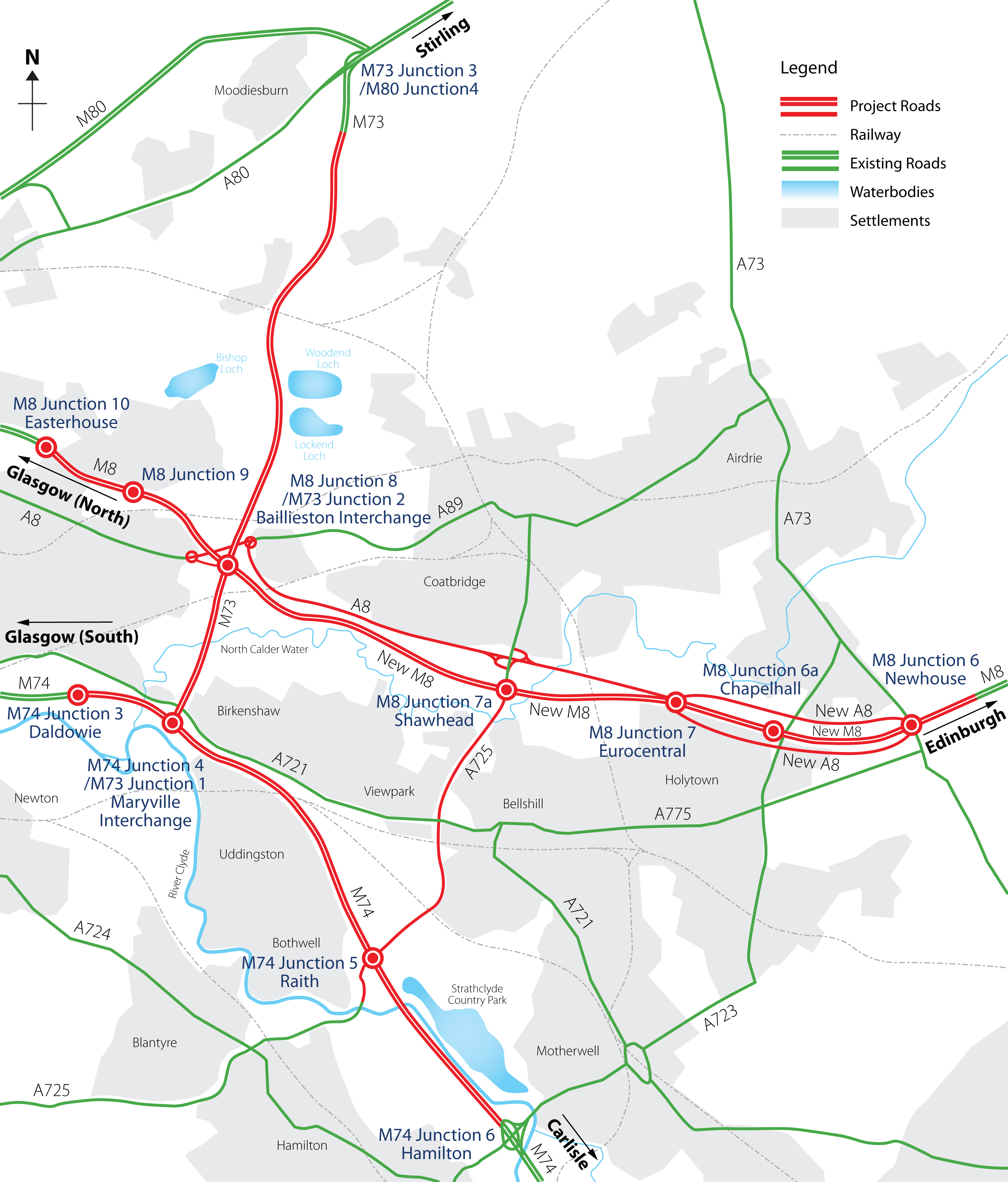
The story of the project
The project consisted of three main sections:
- The new M8 motorway link
- M74 Raith Junction improvement, and
- Network upgrades
The new M8 motorway link
The new M8 motorway link completed the motorway between Glasgow and Edinburgh, connecting the motorway at Baillieston to the motorway at Newhouse.
From Baillieston, the new motorway follows a route south of the existing A8 until Eurocentral and then is constructed on the line of the existing A8 between Eurocentral and Newhouse.
The existing A8 trunk road has largely been retained between Baillieston and Eurocentral with a new two lane carriageway constructed on either side of the new motorway for the new A8 to Newhouse. The A8 trunk road provides easy access to the motorway and adjacent communities.
M74 Raith Junction improvement
Raith Junction is a roundabout linking the M74 motorway with the A725 Bellshill Bypass and East Kilbride Expressway.
A new underpass has been constructed to separate traffic on the A725 from the M74 traffic and local traffic using the roundabout, with three new bridges also constructed to carry the motorway and roundabout traffic over the underpass.
A new cycleway and walkway was constructed across the new junction, to improve accessibility and safety for non-motorised users, providing a link between Bothwell and Strathclyde Country Park and the surrounding communities beyond.
Network upgrades
A series of enhancements were also made to the network of roads and junctions which connect to the M8, M73 and the M74.
The works included construction of an additional lane at the following locations to tackle congestion at peak times by improving the flow of traffic:
- eastbound carriageway of the M8 from Junction 10, Easterhouse
- Easterhouse to Junction 8, Baillieston Interchange
- northbound and southbound carriageways of the M73 between Baillieston Interchange and Maryville Interchange
- northbound and southbound carriageways of the M74 from Junction 3 (Daldowie) to Junction 5 (Raith)
- southbound carriageway of the M74 between Junction 5 (Raith) and Junction 6 (Hamilton).
Environment
A comprehensive Environmental Impact Assessment (EIA) was carried out for each of the three schemes forming the project and the results published in the Environmental Statements, in accordance with the Environmental Impact Assessment (Scotland) Regulations 1999.
As one of Scotland’s largest infrastructure developments at the time, many comprehensive environmental studies and surveys were undertaken to establish the extent of any potential adverse impacts, and mitigation measures were implemented as part of the works to alleviate such impacts on the environment as far as reasonably practicable. These measures included:
- mammal tunnels, fences and bridges to help continued movement of local wildlife
- extensive landscape planting
- noise attenuation barriers
- sustainable drainage systems
Procurement and funding
The start of the procurement process for the project was announced in December 2011 and bidders competed for the contract throughout 2013. The successful bidder Scottish Roads Partnership (SRP), a consortium with a construction joint venture of Ferrovial Agroman and Lagan, was announced in February 2014.
SRP, through consortium member Amey, is also responsible for managing, operating and maintaining this core section of the motorway network for 30 years following motorway completion.
The M8 M73 M74 Motorway Improvement Project contract had a net present value of £500 million (February 2014), which included the construction, operation, maintenance and finance of the project roads for over 30 years.
The project was the first roads infrastructure scheme and was the largest contract, at the time, to be awarded as part of the Scottish Government’s £2.5 billion Non-Profit Distributing (NPD) model. This helps ensure that public money is being used efficiently.
Following a significant level of international investor interest, funding for the project is being provided by both the European Investment Bank (EIB), and a group of investors managed by Allianz Global Investors, one of the world’s leading integrated financial services providers.
Construction
Scottish Roads Partnership (SRP) commenced work on the project in February 2014.
The initial stages of the works consisted of preparing the final design for the project and undertaking site clearance and ground investigations. These works were vital to inform the final design and develop a robust and efficient construction programme.
There were significant design and construction challenges to overcome throughout the construction period, particularly at these key locations:
- M74 Junction 5 (Raith) – M74/A725 (see more about Raith in our Building Information Modelling (BIM) case study)
- Shawhead Junction M8/A8/A725 (see more about Shawhead in our case study)
- M8 Baillieston Interchange
- M8 Junction 6 (Newhouse)
Following the construction the project roads, the new A725 underpass at M74 Junction 5 Raith opened to traffic on 16 February 2017 and the new M8 featuring new and significantly revised junction layouts was opened to traffic in April 2017 with all other project roads being opened to traffic in June 2017.
Further information on construction of the project including some key project highlights during construction can be found below:
- Raith underpass opening
- Project flyover - 2016
- Aerial project images - 2016
- Bo’ness Road Bridge Demolition
- M8 North Calder Water Bridge - beam lift
- Braehead Rail Bridge
- A8 Glasgow and Edinburgh Road Bridge Demolition
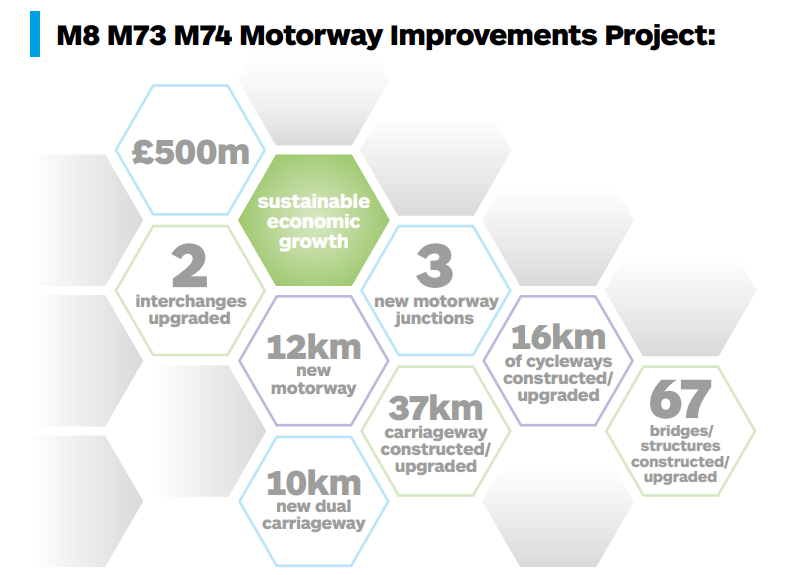
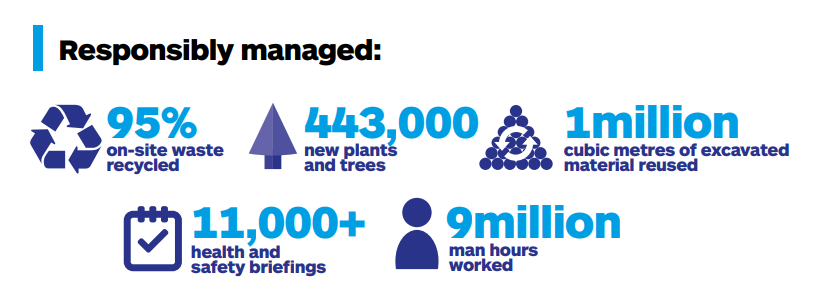
Supporting local labour
Throughout its duration, the project supported a significant number of local labour, construction, supplier and sub-contractor jobs as part of SRP’s skills pledge. Further information on benefits delivered by the project can be found under Benefits and Outcomes.
Case Study - Shawhead Junction
Shawhead Junction
The operation of the roads around Shawhead Junction was a key element of the successful construction of M8 M73 M74 Motorway Improvements Project. It was amongst one of the busiest and most heavily congested junctions to be upgraded as part of the Project and also posed many significant design challenges that required to be overcome.
Situated between the communities of Whifflet and Coatbridge in the north and Bellshill and Bothwell to the south, Shawhead Junction facilitates links via the A725 to both the local and trunk road networks.
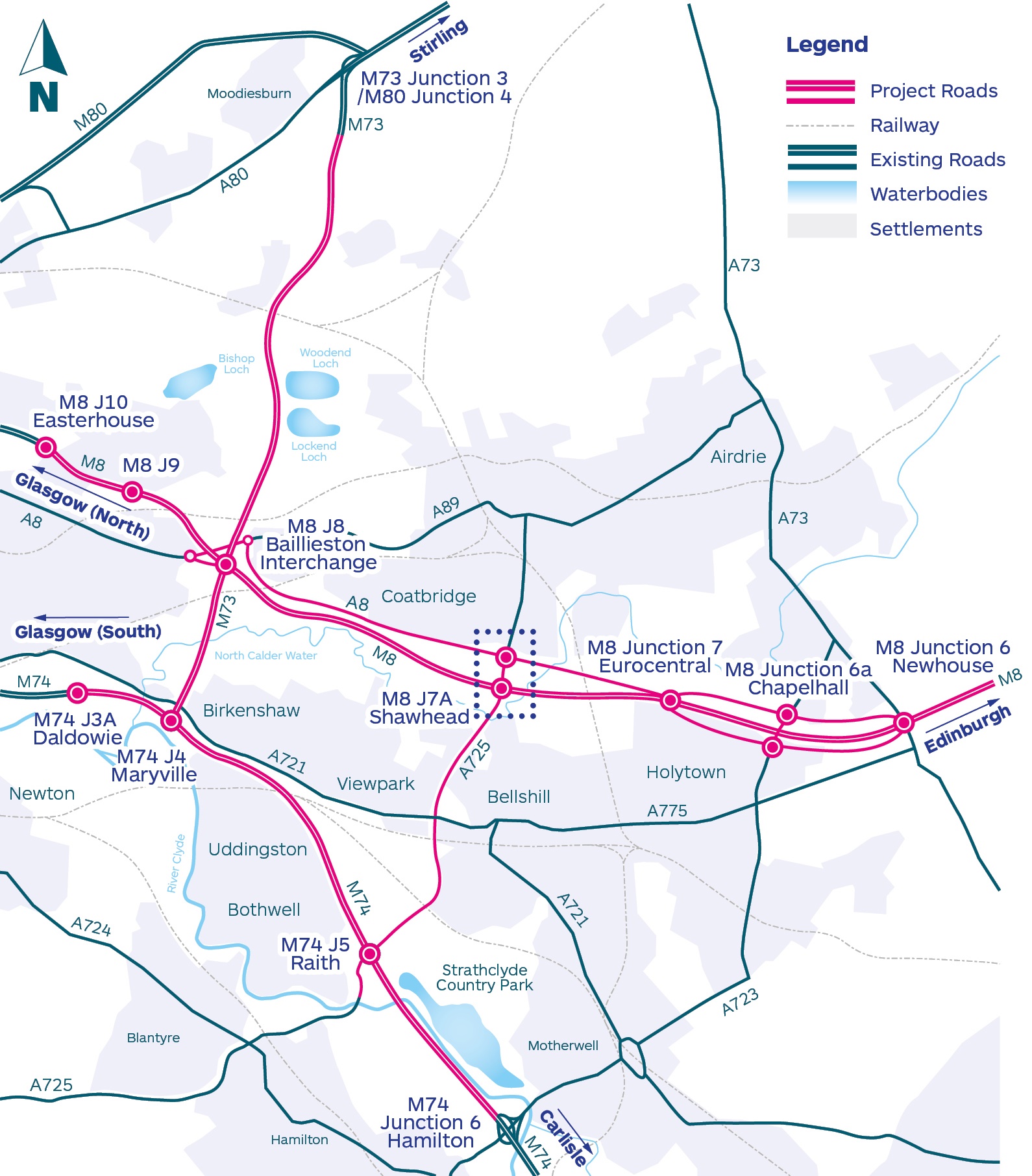
Shawhead Junction consists of the following three junctions and slip roads connecting the various trunk roads and local roads in the area:
- The northern junction between A725/ Kirkshaws Road/ Hagmill Road
- The junction between the A725 / A8 eastbound slip road
- The southern junction between A725/ North Road/ A8 westbound slip road
- The link roads directly connecting the M8 with the A725.
The upgraded junctions and additional connections at Shawhead have:
- Reduced journey times and queueing
- Improved connectivity between the local and trunk road networks
- Improved access to areas of employment, through better connectivity
- Improved connectivity for pedestrians and cyclists.
They're anticipated to act as a catalyst for economic development in the area.
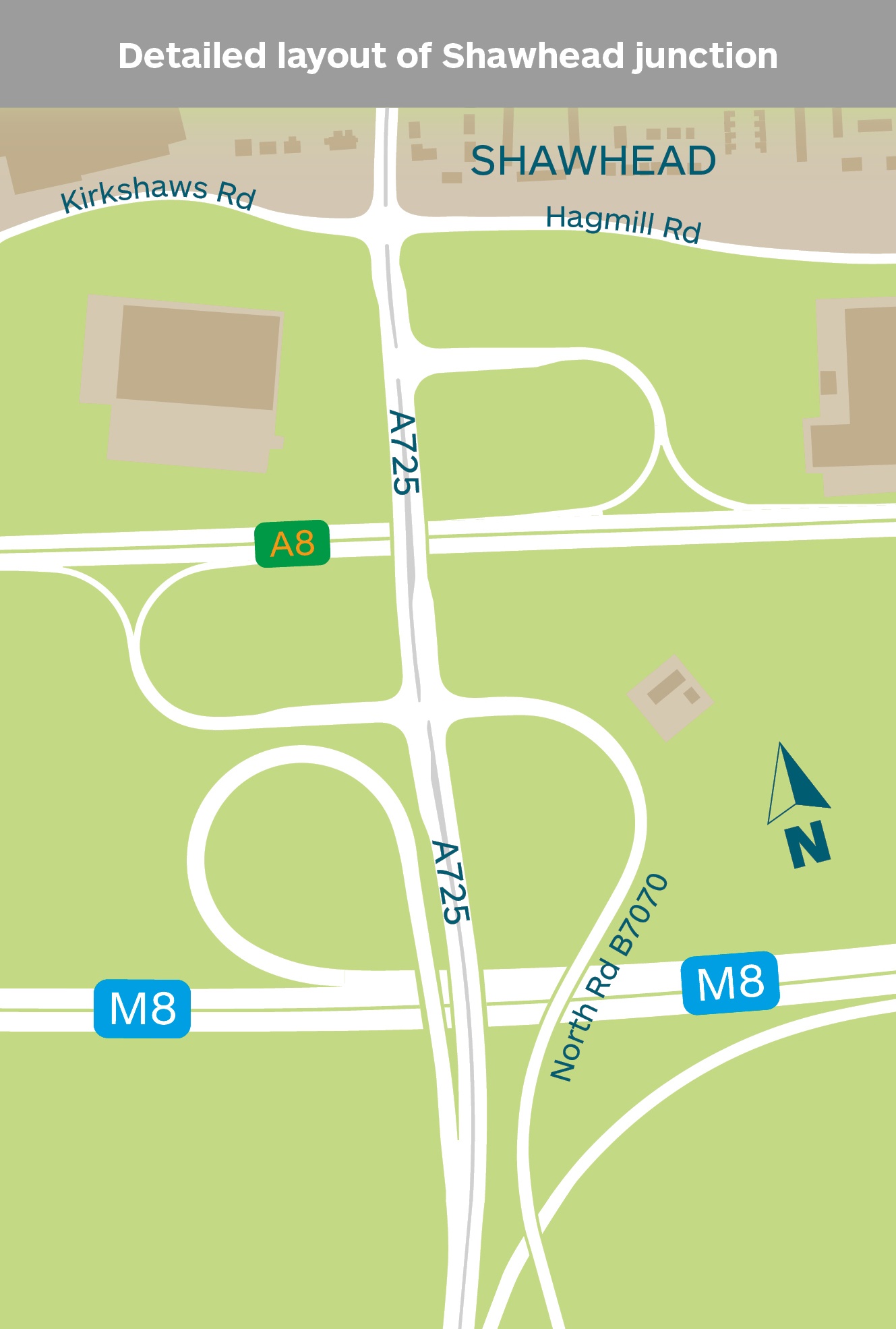
A challenging location
During the construction, keeping roads open and traffic moving on the A725 and the adjacent local road network was only one of the key challenges at this constrained location. Our contractor also had to manage the following challenges:
- Diversion of a significant number of major utilities in the area (including gas, power and communications cables for various companies)
- Design and treatment of a significant extent of historic mine workings in the area
- Reducing adverse impact and disruption during construction on residential dwellings adjacent to the works
- Minimising impact on industrial and business land adjacent to the works
- Visual impact from structures and embankments
- Connectivity to local communities and businesses including consideration of Non-motorised users (NMU’s)
- Reducing impact of the construction on adjacent landscape such as woodland and watercourses
- Minimising habitat loss for plants and mammals
- keeping traffic moving and roads open during construction.
Design development
Plans to upgrade the A8 to motorway standard were announced in 2003 and since then, the conceptual design for Shawhead was developed. In 2006, the assessment report for the scheme noted that the traffic volumes on the section of the A8 around Shawhead exceeded the available capacity on the road network at peak times, leading to queuing and delays to journey times.
The junction strategy for the new motorway, which aimed to separate longer distance trunk road traffic from vehicles making local journeys, was developed as part of the assessment report. At Shawhead Junction, the assessment recommended three signalised junctions on the A725; the most northern junction replacing the mini roundabout on Kirkshaws Road and Hagmill Road, the replacement of the roundabout at the top of the slip road from the eastbound A8 and a third signalised junction connecting the B7070, North Road with the A725 and a westbound A8 slip road.
The use of signalised junctions at each of these locations provides a more reliable form of traffic control over the three closely spaced junctions than was available with the previously.
During the design development process, extensive consultations including public exhibitions and drop-in events took place with local communities and stakeholders on the proposals for the project.
For further information on all exhibitions and drop in events undertaken as part of the initial design development stage, see our Community engagement page.
Design of Shawhead Junction
Our contractor’s designer has undertaken the final design for the junctions in accordance with relevant standards and guidance to:
- minimise future delay and disruption to road users
- meet specific performance criteria which were determined using complex traffic modelling to ensure each junction could accommodate the predicted traffic flows through the junction, whilst at the same time providing journey time savings and reduction in queuing.
Our contractor’s designer benchmarked its traffic modelling analysis against key indicators at each junction separately to determine:
- traffic flow rates at peak times through each junction
- average and maximum queue lengths for each approach arm
- journey times for specific movements.
As part of the design our contractor has equipped the three signalised junctions with smart technology to deliver:
- reduced queuing
- improved journey times
- efficiently managed traffic flows for all users.
You can read more about how this technology works in our leaflet or view our information video.
In addition, the design for the junctions at Shawhead incorporates several improvements for non-motorised users (NMUs), separating them from road traffic where possible and encouraging safe, environmentally friendly travel for both work and leisure.
This included two significant new footbridges and a network of paths for NMU’s that re-connect the communities of Bellshill and beyond to the south and Coatbridge and beyond to the north, as well as providing dedicated access to key employment areas including Strathclyde Business Park and Eurocentral.
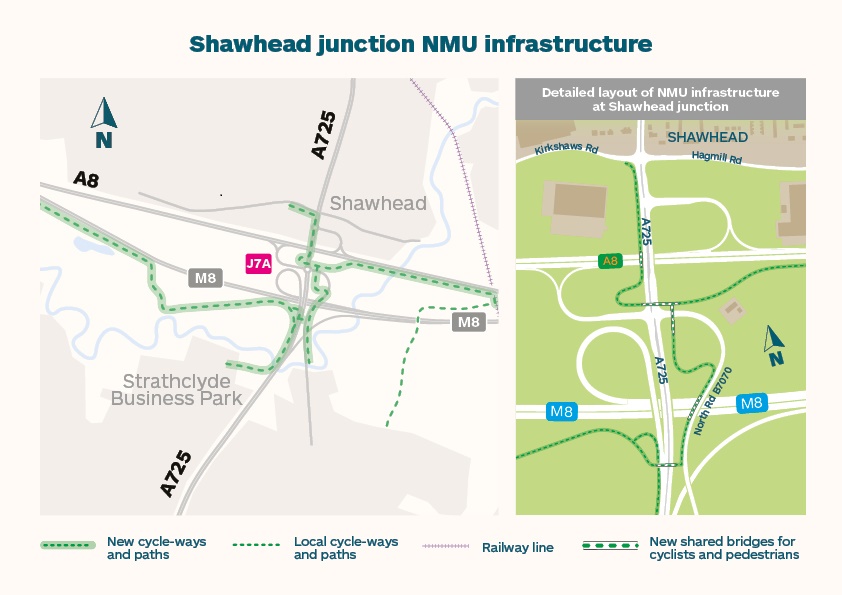
Construction
Shawhead was a critical area to the overall project, due to its complexity and the need to keep two lanes of traffic running on the A725 throughout the construction phase. It was also a priority to keep the B7070 open, significantly reducing disruption for local traffic and for local residents.
A selection of images showing the construction taking shape at Shawhead
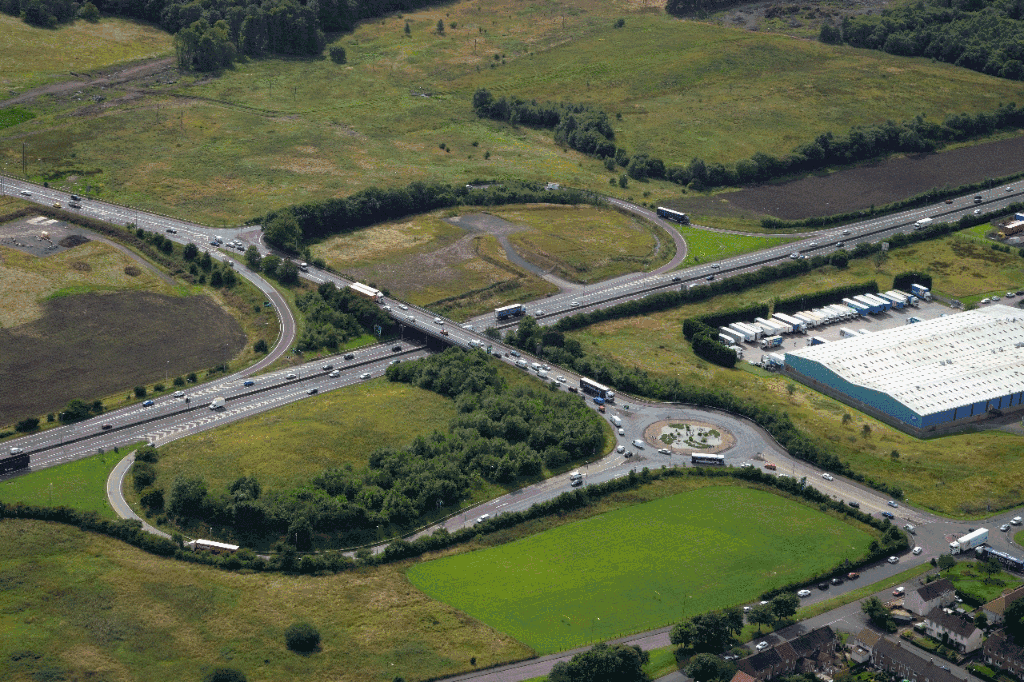
We are often asked
Why is there no dedicated right-turn filter lane to Kirkshaw Road or Hagmill Road from the A725?
The area of land available for the construction and final layout of Shawhead Junction was constrained by the presence of significant utilities in the area, the presence of residential properties, historic mine working and protected environmental assets as well as land designated for development. Further information can be found in the Environmental Statement for the project.
The design of the junction, to fit with the overall junction strategy for the project was carefully considered and modelled, taking into consideration the predicted future traffic as part of the design development process.
This development of the conceptual design determined that the predicted flows of traffic and journey time savings could be accommodated and the operation of the junction optimised without a dedicated right-turn filter lane, within the land available for the works, thereby avoiding negatively impacting on the environment or adjacent properties.
Since the project was opened fully to traffic in 2017, journey times through the Shawhead Junction have significantly improved and queuing on junction approaches has significantly reduced.
Occasionally A725 traffic is given priority and moves twice before Kirkshaws Road traffic gets a green light to turn right, why is this?
The traffic signals across the junctions at Shawhead are equipped with technology that simultaneously monitors traffic in real time and feeds back information to the signal controller. This signal controller also simultaneously processes the traffic data and adjusts the traffic signal timings to optimise queuing on all approaches and the efficiency for all vehicle movements through the junctions.
Given the proximity of the A725/Kirkshaws Road/Hagmill Road and the A725/A8 slip-road junctions, there is limited road space for queuing traffic between the junctions. The wireless technology at these junctions facilitates coordinated communication between both junctions and the signal controller so that the operation of both junctions is optimised.
The signal controller may, for example, give a longer green light period to through traffic on the A725 at peak times to reduce queuing for the greatest traffic flow demand. This would result in traffic on the side roads waiting slightly longer than at off-peak times before being given a green light.
The filter arrow doesn’t work?
The junctions are designed to optimise traffic flows through the junction, so the filter arrows may not operate when there is only one vehicle waiting, to give priority to other traffic flows with greater demand.
The traffic signals at the Shawhead junctions are equipped with technology that can detect vehicles through a network of sensors which are located above and below ground. These sensors wirelessly feedback information to the signal controller to activate the right-turn filter signal.
The sensors will tell the receiver wirelessly when there is a queue of vehicles waiting to turn right and then trigger the filter arrow.
Case Study - BIM
The use of Building Information Modelling (BIM) during construction
The project was one of the first major road projects in Scotland to pioneer the use of BIM - a cutting-edge 3D technology which is revolutionising civil engineering.
BIM uses digital technology to help design, build, maintain and manage construction projects more effectively throughout their lifecycle. As the most complex part of the project to be up-graded, Raith Interchange, Junction 5 of the M74, was selected as an ideal area in which to trial BIM as it could be treated as a stand-alone section.
An intelligent 3D model of all the new infrastructure at Raith Junction was created, which included everything from the underground location of utility services to the type of street lighting installed – even details down to the wattage of a bulb to be replaced – was all available at the touch of a button using BIM.
At Raith Junction, the engineers had the challenge of constructing the underpass below the water table given the nearby River Clyde, as well as relocating a significant number of underground utilities. BIM was instrumental in the success of the construction of the new junction and Transport Scotland is committed to supporting the construction industry to deliver greater efficiencies through the design, construction and operational stages of projects, through the use of BIM.
Some key benefits of the use of BIM at Raith Junction included:
- Reduced risk due to greater visibility and collaboration between design and construction teams
- Reduced errors during on site construction due to design clash detection on the virtual model
- Improved safety by replicating construction methodology on the virtual model
- Reduced information loss between project phases, ensuring the capture and handover of full asset information from construction to the Operations and Maintenance phase
Find out more from the BIM video
An image of the new Raith Junction generated using BIM technology
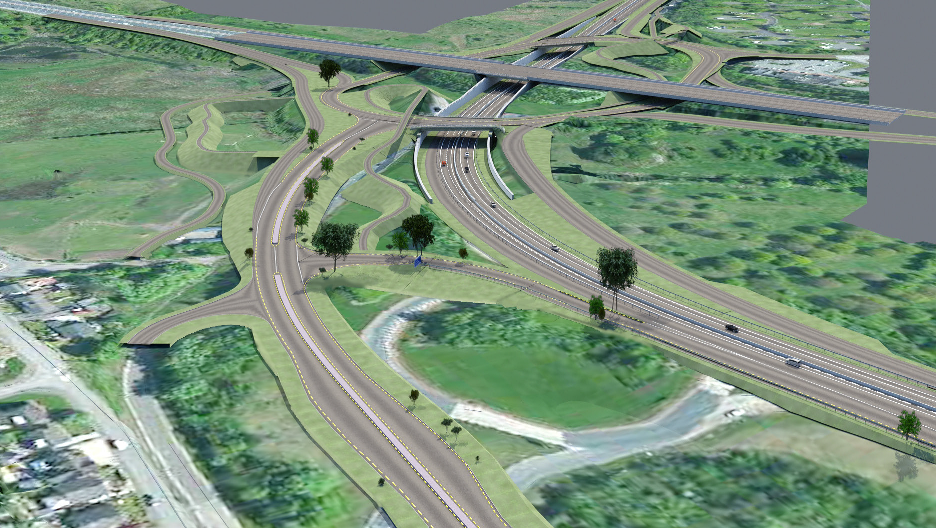
Aerial view of Raith Junction 5 of M74 during construction circa November 2014, prior to piling of the underpass
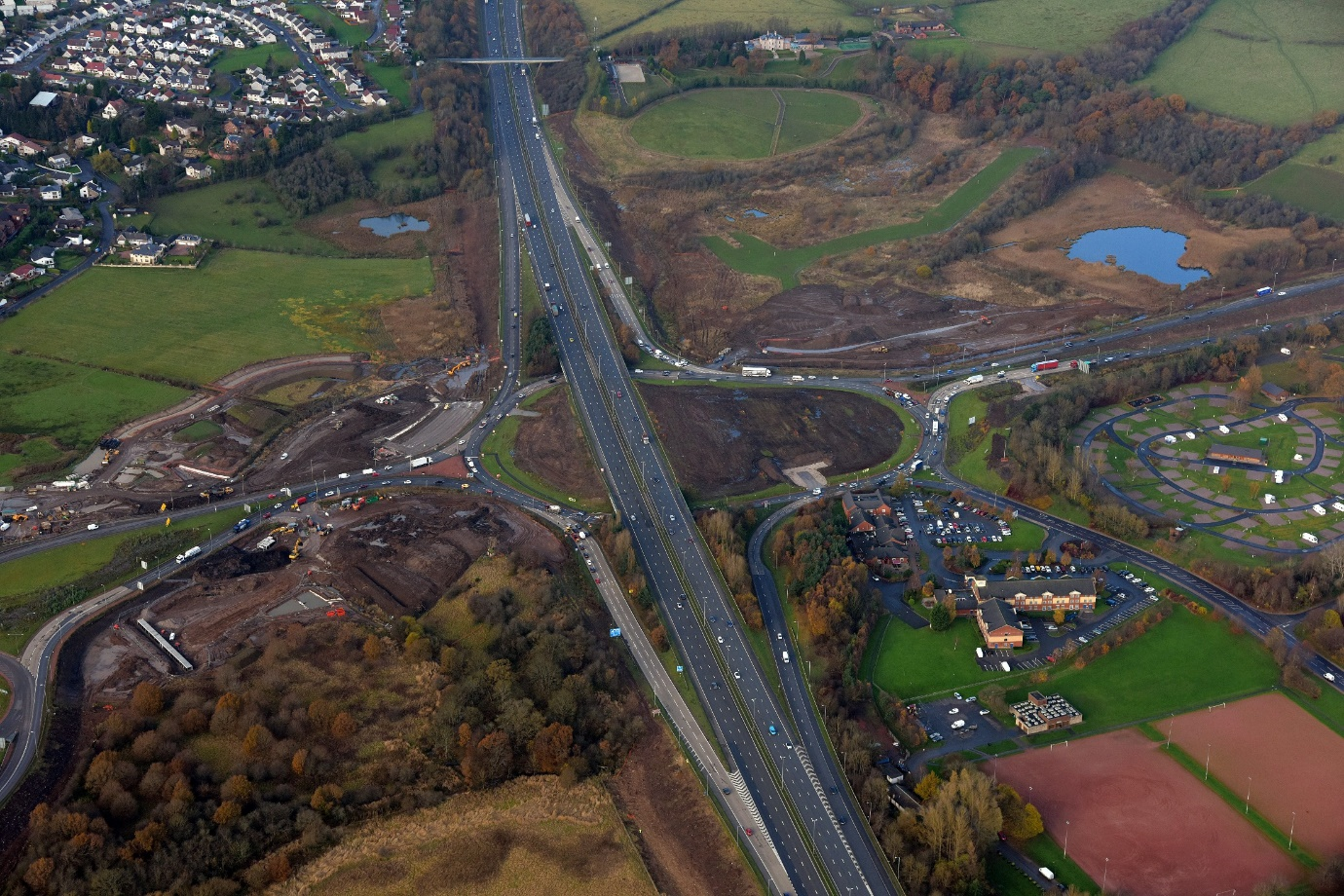
Aerial view of Raith Junction during construction circa Dec 2016, showing completion of piling and emergence of the A725 underpass below the M74
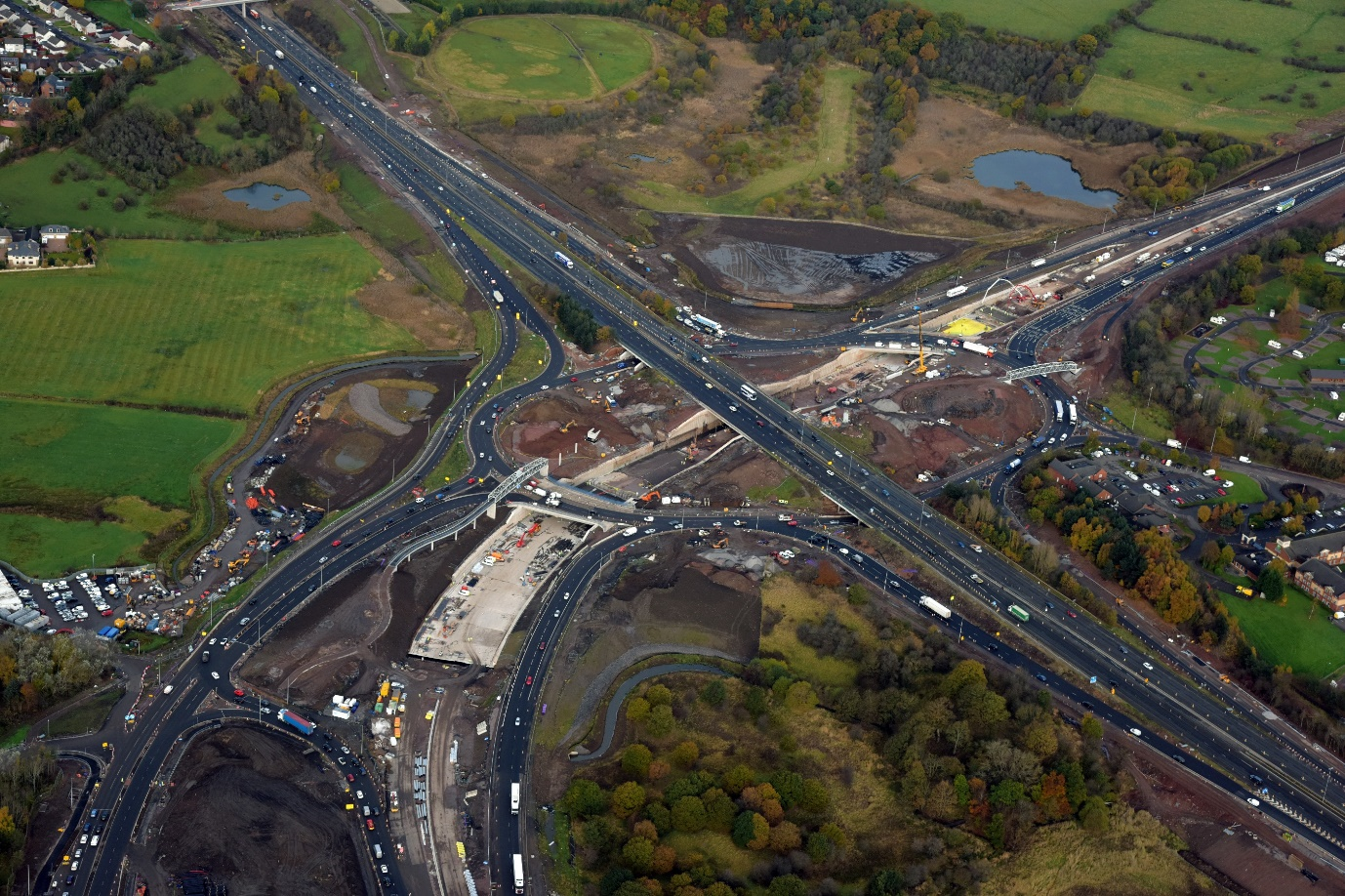
Benefits and Outcomes
In addition to the upgraded infrastructure, during the construction phase of the project, our Contractor for the project, Scottish Roads Partnership delivered:
- 40 vocational training apprentice site placements
- 27 professional graduate training site placements
- 104 sub-contract opportunities advertised through Public Contracts Scotland procurement website
- 8 training opportunities during construction such as placements, work experience and workplace 'taster' opportunities aimed at young and local individuals
The Operation and Maintenance phase of the project has also provided 50 long-term employment opportunities to date.
Read about the experience of one of our graduate engineers
Scottish Trunk Road Infrastructure Project Evaluation (STRIPE)
Transport Scotland is undertaking an evaluation of the M8 M73 M74 Motorway Improvements Project, in line with the Scottish Trunk Road Infrastructure Project Evaluation (STRIPE) Guidance, against both its objectives and wider evaluation criteria.
The evaluation aims to assess the impact of the scheme by comparing conditions one year and then three years after opening with forecasts made during scheme design and development.
The main areas evaluated include: scheme objectives; environment; safety; economy; integration; accessibility and social inclusion; and cost to government. As a large road infrastructure project, an evaluation will also be undertaken five years after opening. The evaluation reports will be published on our website.
Key statistics - new infrastructure

Objectives
The Scottish Government has five policy objectives and the M8 M73 M74 Motorway Improvements Project has aimed to meet each of these, as outlined below.
1. Economy
The M8 M73 M74 Motorway Improvements Project aimed to:
- tackle the risk of congestion from traffic growth associated with key developments along the M8 and A725 corridors.
- reduce average travel times for key journeys throughout the corridor at peak periods by separating motorway and local traffic and reducing conflicting movements at major interchanges.
- cut congestion by segregating the A725 through traffic at M74 Raith Junction, removing significant traffic volume from the roundabout and supporting wider journey time benefits on the M8 and surrounding network.
- improve journey times by 15 to 20 minutes and improve the reliability of journey times on the A725 and M74
- support development opportunities identified in and around the M8 and A725 corridors
- relieve traffic congestion at peak times on the M8, M73 and M74 motorway network in the vicinity of Baillieston and Maryville Interchanges
- reduce predicted North-South (M80-M74) delays by up to 18 minutes in the evening peak hour and predicted West East (M74-M8) delays by up to 6 minutes in the morning peak hour
2. Safety
The M8 M73 M74 Motorway Improvements Project aimed to:
- enhance carriageway and junction layouts; relieving congestion and improving weaving opportunities between junctions
- through a new M74 junction 5 (Raith) - reduce the potential for vehicular accidents by removing traffic from the existing roundabout and providing free-flow conditions onto the A725. It also aimed to reduce the potential for conflicts between pedestrians and cyclists and motor vehicles
3. Environment
The M8 M73 M74 Motorway Improvements Project aimed to:
- minimise the overall impacts on adjacent designated sites
- enhance the habitat at M74 junction 5 (Raith) by use of adjacent flood compensatory areas as additional wetland
- reduce impact on landscape and mitigate visual impacts
- provide local benefits to air quality and noise levels from the improvements
- include a sustainable drainage system treating runoff from areas of the existing motorway network
4. Integration
The M8 M73 M74 Motorway Improvements Project aimed to:
- provide a motorway connection to Eurocentral, improving transport links across Central Scotland and beyond
- complement existing planning policies for the area and provide the key to unlocking the benefits of adjacent improvements to the Central Scotland Motorway Network
5. Accessibility
The M8 M73 M74 Motorway Improvements Project aimed to:
- improve access to the motorway network for road users
- provide almost 10 miles of new and improved pedestrian and cycle routes linking existing walking and cycling routes and improving the connections between local communities, businesses and areas of employment. The new routes have been designed to be accessible to all user groups
- provide free-flow traffic conditions at the M74 Raith junction, addressing the reasonable needs of traffic seeking to access the Central Scotland Trunk Road Network
- segregate walkway and cycleway facilities to significantly improve conditions for non-motorised users helping to provide safer connections between Bothwell and Bellshill alongside adjacent recreational routes
Operation & Maintenance
The M8 M73 M74 Motorway Improvements Project was fully opened to traffic on 1 June 2017.
Scottish Roads Partnership (SRP), through its subcontractor Amey, is responsible for managing, operating and maintaining this core section of the Scottish trunk road network on behalf of Scottish Ministers until 2047.
The extent of the trunk road network for which SRP is responsible is shown in this diagram:
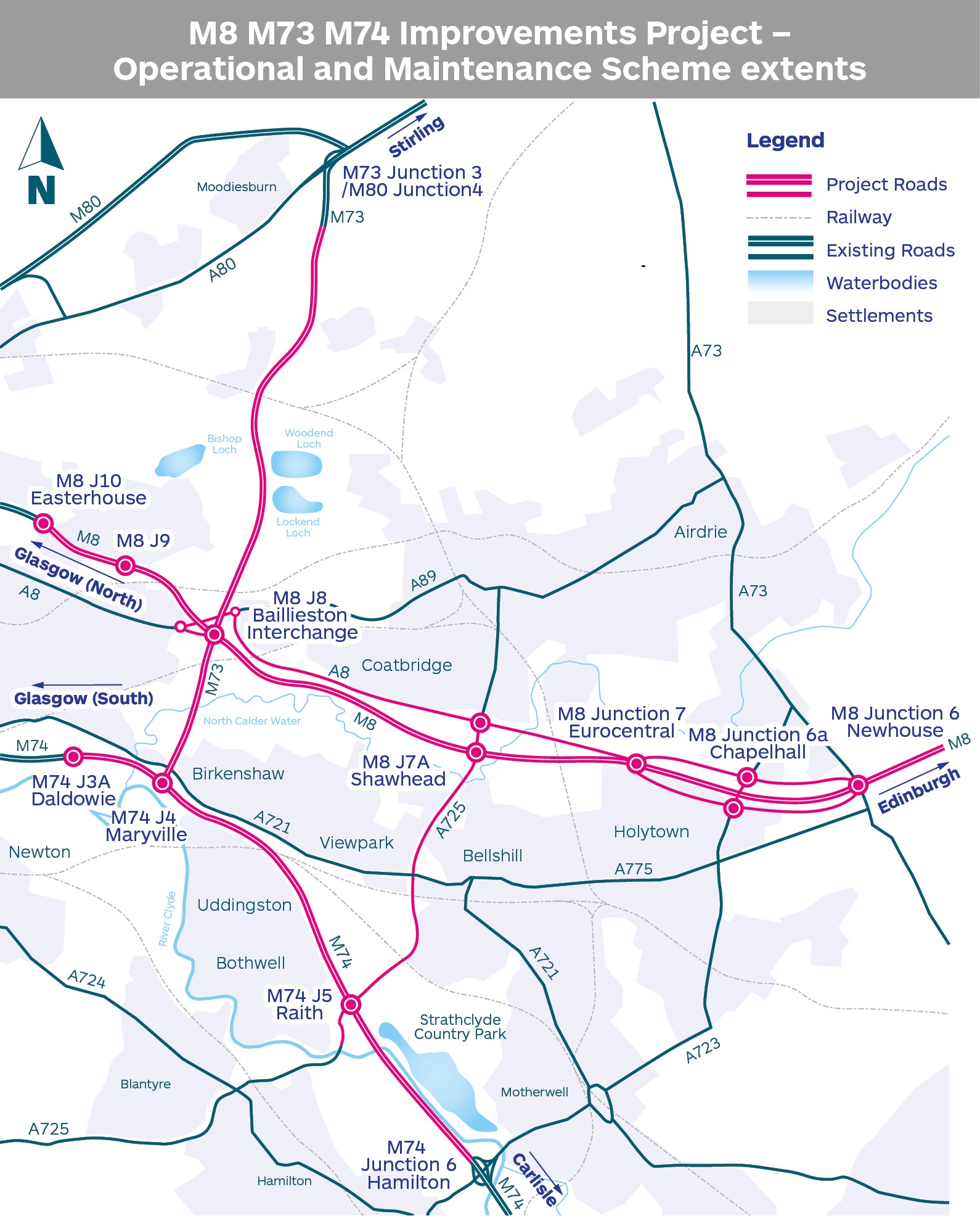
SRP is responsible for a range of services to keep the trunk road network operational and safe for use, that include:
- winter maintenance activities
- incident response services
- inspections and surveys
- identification and repair of defects.
From time to time, SRP may require to undertake works to maintain the road network and this may require traffic management. For updates on SRP traffic management necessary for operation and maintenance of the new motorway and trunk road network, see the Traffic Scotland website, or follow @trafficscotland on Twitter.
Community Engagement
Community engagement is a vital part of the project, from the early stages of design & planning, throughout the construction phase, and beyond to the essential operation and maintenance of the new trunk road and associated infrastructure.
Scottish Roads Partnership, our contractor for the operation and maintenance for the new project roads, regularly engages with local stakeholders, road users, local residents and businesses to keep people informed of any works and associated traffic management that may affect them.
This engagement includes emails to stakeholders directly affected by potential works, press releases, travel bulletins and social media up-dates to the media, as well as regular up-dates on the project and Traffic Scotland website. Quarterly newsletters were also produced during the construction phase of the project.
For further information regarding the M8 M73 M74 Motorway Improvements Project, please contact:
Scottish Road Partnership
1E Willow House, Kestrel View, Strathclyde Business Park, Bellshill ML4 3PB
Email: info@scotroadspartnership.co.uk
Telephone: 0800 042 0188
Scottish Road Partnership also has a dedicated project website.
Historic exhibitions & consultations
Prior to construction, consultation took place over many years to show the community examples of what the finished road network would look like following the upgrading and improvement works that formed part of the M8 M73 M74 Motorway Improvements Project. These consultations were held with statutory and non-statutory bodies including Local Authorities, the public, Scottish Natural Heritage (SNH), Scottish Environment Protection Agency (SEPA), interest groups, businesses, landowners and more.
To keep local communities and road users informed of the developing proposals and construction progress, numerous public exhibitions, meetings, and leaflet drops were undertaken.
View a summary of the consultations
The timeline below outlines the journey of the M8 M73 M74 Motorway Improvement Project from early consultation and Public Local Inquiries (PLIs) through to construction and the opening of the new roads.
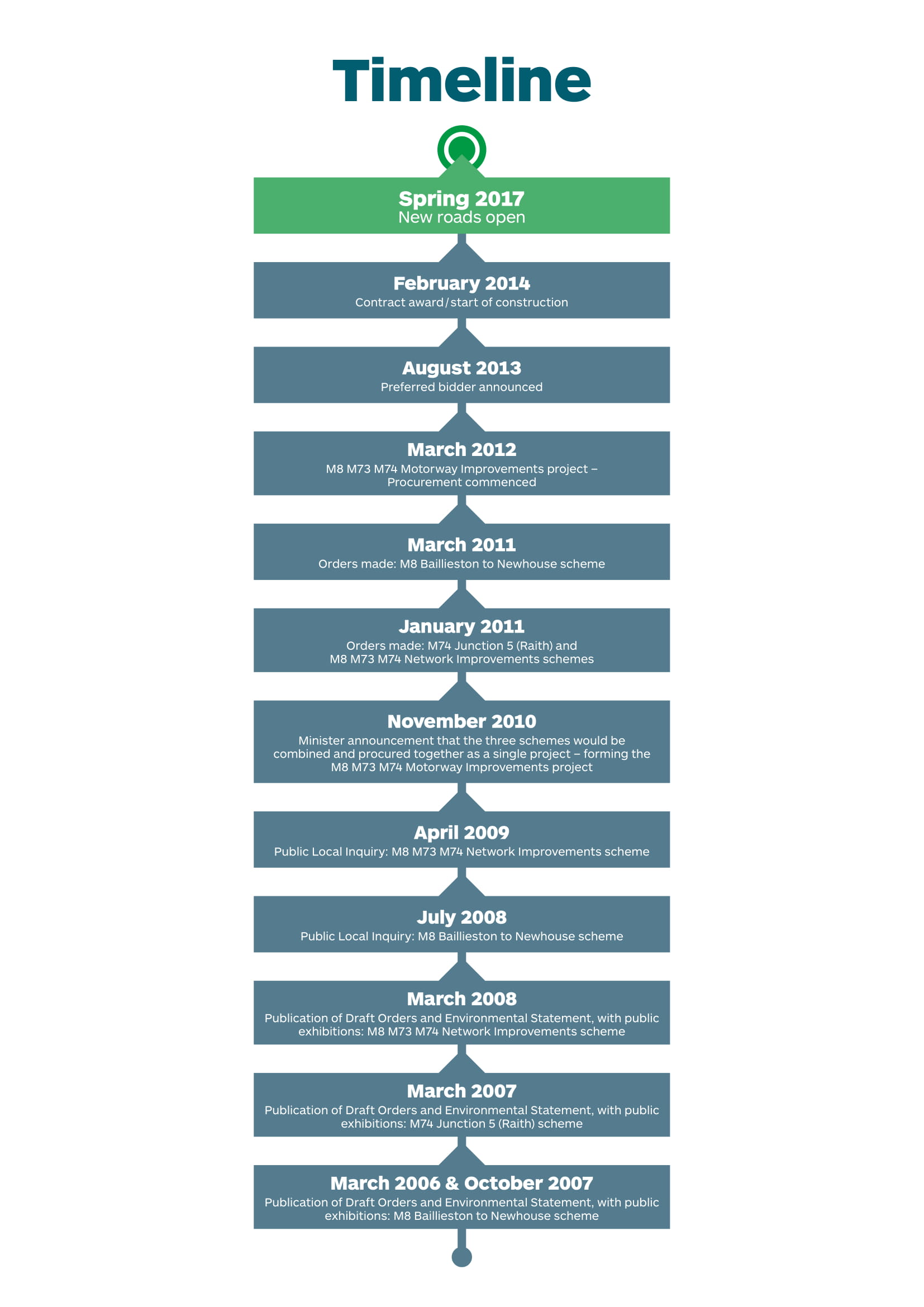
View historic publications relating to the project
Community Benefits
Preserving the Precious Environment of Cander Moss
As part of sustainability week in Spring 2014, ten members of the project staff volunteered to help Scottish Wildlife Trust conserve Cander Moss Nature Reserve.
As part of a wider management plan to re-wet the 24 hectare peat bog and restore its ecosystem, work was undertaken to protect the reserve and its’ unique species by preventing it turning back to woodland. The prime objective of the maintenance of the moss is wildlife conservation.
Cander Moss is located near the village of Stonehouse, east of the M74 motorway: it is owned and managed by the Scottish Wildlife Trust. This lowland raised bog is a naturally formed dome of peat that started its life as a loch or marshy hollow after the last Ice Age about 10,000 years ago, kept wet purely from the high amount of rainwater that falls on it.
Monitoring of the water level in Cander Moss showed that the dams installed in the ditches raised the water table significantly, but there is still too large a fluctuation occurring throughout the year, so additional tree felling around the edges and continued control of the seedlings and saplings on the open bog is essential to help it recover further.
The practical conservation work undertaken by the group made a lasting difference to preserve the rare raised bog habitat and species found there. It also helped prevent carbon locked in the peat from being released into the atmosphere.
As well as the vast array of mosses, bogs support a whole range of other species including plants like bog asphodel and insectivorous sundews and wildlife such as bees, moths and butterflies, lizards, newts, frogs, toads and a whole host of birds including meadow pipits, stonechat, short-eared owl and harriers.
This rarity and diversity means that many sites, including Cander Moss are legally protected and have been designated as a Site of Special Scientific Interest (SSSI).
Conservation management is necessary at the Cander Moss to ensure it is kept in optimum condition for wildlife conservation and scientific and educational studies.

The M8 M73 M74 Motorway Improvements Project team volunteering with the Scottish Wildlife Trust at SSSI to preserve Cander Moss
Spreading a little Christmas Magic
The M8 M73 M74 Motorway Improvement Project brought a little bit of festive cheer to those who needed it most in December 2014. Over the winter period, the Operation and Maintenance and Construction teams worked with a number of worthy charities delivering toys, gift vouchers and raising money for some of the most vulnerable in society.
A 'Sustainable Santa' initiative saw project staff collect more than 2.2 tonnes of toys from Scottish primary school children the week before Christmas. Pupils were asked to recycle their old and unwanted toys, books and games to worthwhile causes rather than sending them to landfill.
The estimated value of the toys collected, many of which were immaculate or unopened, was in excess of £2,000. A number of local charities benefited from the toy collection including Airdrie Foodbank, Scottish Refugee Council, St Andrew’s Hospice in Lanarkshire and the toy recycling charity, Good Green Fun.
The project staff also contributed to Airdrie Foodbank by holding a selection box appeal, and filled four large sacks with chocolate goodies for local families. Ferrovial Lagan Joint Venture (FLJV) also presented £500 of gift vouchers to the Children’s Hospice Association Scotland (CHAS) which enabled the charity to buy presents for the families supported by the charity.
CHAS is a charity that provides the only hospice services in Scotland for children and young people who have life-shortening conditions for which there is no known cure. CHAS runs two children’s hospices, Rachel House in Kinross and Robin House in Balloch, and a home care service called CHAS at Home.

Pamela Ward, SRP liaison officer presenting £500 worth of gift vouchers to Scot Maxwell, CHAS fundraiser
Another charity to benefit from the project was Crisis Skylight in Edinburgh, which helps bridge the gap many homeless people face in gaining the skills, qualifications and confidence required to break the cycle of homelessness. Since opening in 2010, it has had a significant impact on the lives of hundreds of homeless people.
Ferrovial Lagan Joint Venture (FLJV) raised £2,280 for the Crisis Skylight team which helped the worthy cause provide a warm and welcoming environment and the chance for their Christmas guests to make a fresh start in the New Year.

Raul Pascual, FLJV Project Director presenting £2,280 cheque to Elsie Riley, Crisis Fundraising Manager, Scotland
Community groups benefit from Good Neighbour Fund
Christmas 2015 came early for three local community organisations, each benefitting from a cash windfall thanks to the £500m M8 M73 M74 Motorway Improvements Project.
Bothwell Horticultural Society, Viewpark Conservation Group in Uddingston and Hattonrigg Senior Citizens Club in Bellshill, were among the first local community groups to benefit from the Good Neighbour Fund.
The Good Neighbour Fund was established by Scottish Roads Partnership (SRP), to give something back to the local communities in close proximity to the works.
Members of The Bothwell Horticultural Society (BHS) were presented with a cheque for £500 at the Butterfly Sensory Garden on Bothwell Main Street in December 2015.
Harry Marsh, secretary, and Morag Smith, former president of Bothwell Horticultural Society, accepted the cheque on behalf of the organisation.
Mr Marsh, said: "The re-vamped sensory garden is a popular attraction for many children and families living in the village. This funding which has been kindly donated by SRP will be used to install a new information board at the entrance to the garden and is very gratefully received."
Similarly, members of Hattonrigg Senior Citizens Club in Bellshill enjoyed a day trip to The Kelpies next to the Forth and Clyde Canal and the Falkirk Wheel, and Viewpark Conservation Group created a calendar to showcase the diverse wildlife and beautiful scenery on Viewpark’s doorstep.
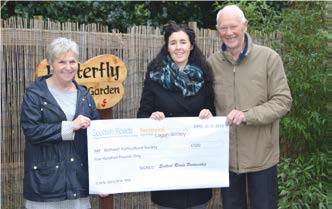
Morag Smith, former president of BHS, Pamela Ward of Ferrovial Lagan and Harry Marsh, Secretary of BHS
Sharks Make a Splash in Sheffield
Bellshill Sharks Amateur Swimming Club made a big splash thanks to a £500 award from Scottish Roads Partnership’s Good Neighbour Fund.
The club, dedicated to developing the skills of talented young swimmers from 8 to 18 years, benefitted from the funding initiative set up to support communities living in close proximity to the M8 M73 M74 Motorway Improvements Project.
The Bellshill Sharks used the cash injection to help fund their entry into a swimming competition in Sheffield on in September, 2016.
The money enabled 35 young swimmers to participate in the Sheffield Teaspoons Meet, giving them the opportunity to compete against some of the top swimmers south of the border.
Club secretary Lorna Carlyle, said: "By competing in this meet, the squads were given the opportunity to improve performance, develop new skills and confidence - particularly in our young swimmers, and develop a sense of team spirit."
Scottish Roads Partnership (SRP) set aside a total of £15,000 to offer grants of up to £500 to local groups and organisations through the Good Neighbour Fund.
Schools Road Safety Poster Competition
Two budding artists from primary schools in North and South Lanarkshire lifted a top prize of £250 for their school in a competition to design a road safety poster.
The competition, run by Scottish Roads Partnership (SRP), challenged local primary school children to design an eye-catching poster to mark National Road Safety Week in November 2015.
In the Primary 4 and under category, the winning poster was created by Neve McAllister (age 7) of Victoria Primary School in Airdrie, who created a colourful design highlighting the potential dangers near pedestrian crossings.
In the Primary 5 and over category, William Walker (age 11) from St. John the Baptist Primary in Uddingston, also won £250 for his school with his design highlighting the dangers of drinking and driving.
Both winning entries were displayed within the project office and were used on suitable construction sites in the local area.

Pamela Ward of Scottish Roads Partnership with winner Neve McAllister of Victoria Primary School in Airdrie
Kids Get Muddy Thanks to Roads Project
Muddy Adventures Community Group, which encourages children and families to engage and learn through nature, received £1,000 from the Good Neighbour Fund £1K Summer Bonus.
The group runs outdoor forest school sessions for 60 youngsters between the ages of 4 and 12, in Strathclyde Country Park. Muddy Adventures, a non-profit community group based in Motherwell, planned to double its numbers and buy vital equipment including childproof cameras and art supplies with the £1,000 award.
Spokeswoman Malissa Bell, said: "This is fantastic news. This money will go far and the children will love it."
Scottish Roads Partnership made a further £500 award to 3rd Blantyre Scout Group to purchase two outdoor shelters to help with the Scout’s conservation project in Redlees Urban Fringe Park near Blantyre in South Lanarkshire.
A total of £15,000 was available to support local groups and organisations through the Good Neighbour Fund with other recipients including: the Celtic Boys 2002 Youth Football Team in North Lanarkshire and the Community Learning & Development Partnership Friday Night Project in Coatbridge.
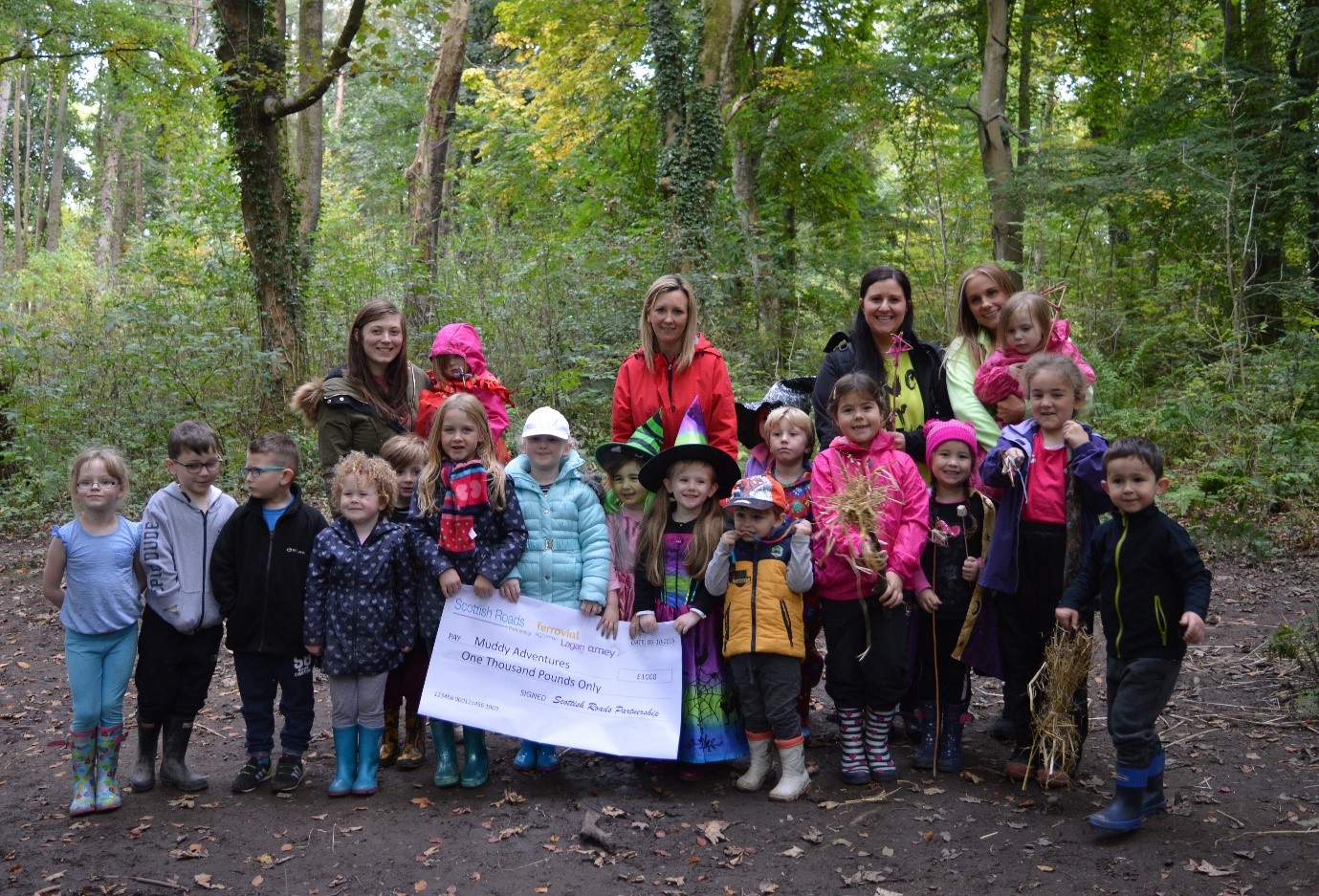
Scottish Roads Partnership presented Muddy Adventures with a bumper cheque for £1,000 from its Good Neighbour Fund
Connecting communities
The M8 M73 M74 Motorway Improvements Project has delivered a significant number of improvements to the active travel network, making new connections between several communities via new pedestrian and cycle friendly routes.
The Scottish Government is committed to developing an Active Nation and has invested in the cycle and foot paths in North Lanarkshire, South Lanarkshire and Greater Glasgow as part of the project.
The new routes have been designed to be safer and more accessible to all user groups, and aim to encourage walking and cycling for short, everyday journeys.
View map showing new cycle and pedestrian paths
This new active travel network has improved the connections between many of the local communities, businesses and areas of employment in North and South Lanarkshire and Glasgow.
Active travel
As part of the M8 M73 M74 Motorway Improvements Project, 16km of new and improved pedestrian and cycle routes were constructed to link with existing walkways and cycling paths, making it easier for everyone to incorporate active travel choices into their daily routines.
By introducing this new network of paths, cyclists and pedestrians are now separated from road traffic, providing safe routes to encourage environmentally friendly travel for both work and leisure.
The most significant features of this investment include a number of new pedestrian bridges at key locations including Raith and Shawhead Junctions, and along the new M8/A8 corridor. These new bridges link many of the communities surrounding the trunk roads for the first time since the 1960s when the roads infrastructure was built, improving access to a range of employment and recreational areas.
This includes connecting Hamilton and Bothwell in South Lanarkshire to Strathclyde Park and the communities in North Lanarkshire, and linking Bargeddie and Coatbridge to the nearby community of Bellshill and Strathclyde Business Park.
The new and improved active travel routes link to National Cycle Network (NCN)74 which connects Greater Glasgow with Gretna on the border with England, and NCN 75, which links Edinburgh and Glasgow along disused railways, riverside and canal towpaths.
The map showing the new routes created as part of the project also highlights local visitor attractions and points of recreational interest, as well as the railway network and the cycling facilities available at each train station to allow you to plan your journey.
The benefits of more people cycling and walking include:
- easing congestion
- reducing noise pollution
- cutting exhaust emissions
- improving health
- giving us more time to enjoy our urban spaces
- saving money